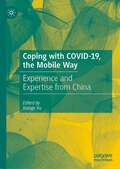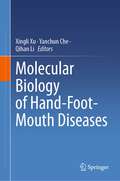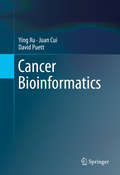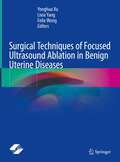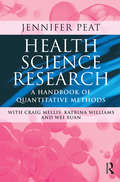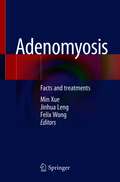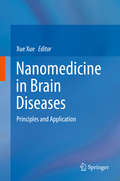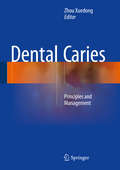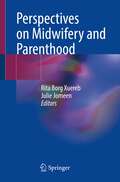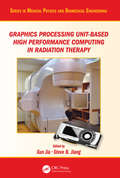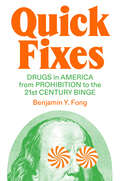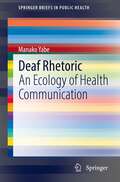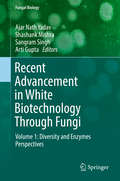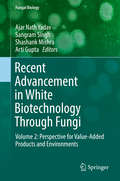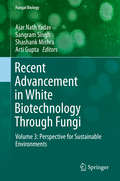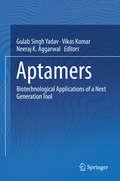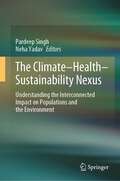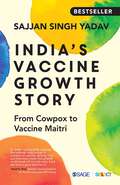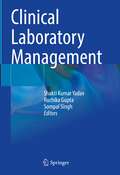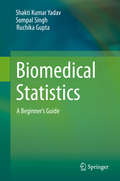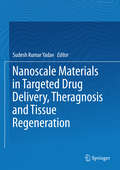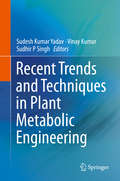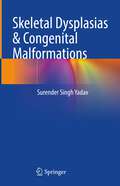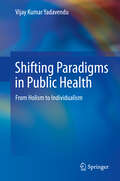- Table View
- List View
Coping with COVID-19, the Mobile Way: Experience and Expertise from China
by Xiaoge XuThis edited book examines the impact of COVID-19 on selected areas of mobile studies, ranging from mobile public spaces to mobile workspaces. This book offers insights into how to leverage mobile devices, as well as features and communication to contain the pandemic. Specifically, it highlights the Chinese experience and lessons, and the country’s expertise in social capital management during the health crisis, governance of information flow and order, combating fake news and the infodemic, documenting the pandemic, and lessons learned from mobile health communication. It also discusses how small companies can survive the death of foreign trade during the pandemic. Looking beyond the pandemic, the book also explores the challenges and opportunities posed by the pandemic by investigating mobile learning, mobile journalism, mobile marketing and mobile workspaces. Given its scope, this book will enhance the global efforts in fighting the pandemic and contribute to the current body of knowledge on how to leverage mobile technologies to enhance public health communication during public health crises.
Molecular Biology of Hand-Foot-Mouth Diseases
by Xingli Xu Yanchun Che Qihan LiThis book aims to compile the latest scientific information on hand, foot, and mouth disease (HFMD), including its epidemiology, etiology, pathology, immune response and vaccine development. Interestingly, the authors shared their own research experience and offered distinctive insights into the pathogenesis of HFMD and vaccine development. The intended audience, including university researchers, graduate students, and vaccine engineers, is well defined. The book is positioned as a resource that not only presents current knowledge but also has the potential to inspire further research in understanding immune pathogenesis and advancing vaccine development for HFMD.
Cancer Bioinformatics
by Ying Xu Juan Cui David PuettThis book provides a framework for computational researchers studying the basics of cancer through comparative analyses of omic data. It discusses how key cancer pathways can be analyzed and discovered to derive new insights into the disease and identifies diagnostic and prognostic markers for cancer. Chapters explain the basic cancer biology and how cancer develops, including the many potential survival routes. The examination of gene-expression patterns uncovers commonalities across multiple cancers and specific characteristics of individual cancer types. The authors also treat cancer as an evolving complex system, explore future case studies, and summarize the essential online data sources. Cancer Bioinformatics is designed for practitioners and researchers working in cancer research and bioinformatics. It is also suitable as a secondary textbook for advanced-level students studying computer science, biostatistics or biomedicine.
Surgical Techniques of Focused Ultrasound Ablation in Benign Uterine Diseases
by Yonghua Xu Lixia Yang Felix WongThis book aims to provide readers advanced information on the clinical application of MRI and ultrasound-guided focused ultrasound ablation for benign uterine diseases. Followed by a brief introduction of the principle and method of focused ultrasound ablation, and imaging diagnosis of uterine fibroids and adenomyosis, typical cases of focused ultrasound ablation treatment for uterine fibroids, adenomyosis and other benign uterine diseases are presented, accompanying with high-resolution illustrations. Key points in imaging diagnosis, efficacy prediction, ablation procedure, and posttreatment evaluation are included. The possible complications and treatment strategies are also discussed. It will be a useful reference for gynaecologists and practitioners to perform focused ultrasound ablation for the treatment of benign uterine diseases.
Health Science Research: A handbook of quantitative methods
by Wei Xuan Craig Mellis Katrina Williams Jennifer K PeatThis is an excellent book, which will be of value to all those health professionals seeking to demystify the sometimes intimidating area of research. Well organised, comprehensive, and clearly written, it is indeed a 'handbook'; it has a clear, step by step approach with many practical examples. It is suitable for researchers across the range of health disciplines, and the authors are to be congratulated for what will become an important resource.Professor Frank Oberklaid, Director, Centre for Community Child HealthUniversity of Melbourne/Royal Children's HospitalThis book will clearly be a great help to young, and to some extent, experienced research workers focusing on epidemiological and clinical questions framed either in terms of the broad community or patient groups. I recommend it warmly.Professor Stephen Leeder, Dean, Faculty of Medicine, University of SydneyHigh quality clinical research is a cornerstone of effective health care and much good research is undertaken by clinicians. Yet many of the resources available on research methods are highly theoretical and inaccessible.Written in a user-friendly style by a team of experienced clinical researchers, Health Science Research guides readers through the fundamentals of clinical inquiry. It outlines the steps needed to plan a study, recruit and select subjects, gather and analyse data, and report on results. The authors also explain how to deal ethically with interviewees, and how to prepare a grant application.Health Science Research is an indispensable guide for anyone who needs to undertake a clinical study, including physicians, nurses, allied health workers, scientists and research assistants.Jennifer Peat is Hospital Statistician in the Clinical Epidemiology Unit at the New Children's Hospital, Westmead, and Associate Professor in the Department of Paediatrics and Child Health at the University of Sydney. Katrina Williams and Professor Craig Mellis are from the same Hospital and Department, and Wei Xuan is from the Department of Medicine, University of Sydney.
Adenomyosis: Facts and treatments
by Min Xue Jinhua Leng Felix WongThis book aims to provide updated facts and treatments for practicing gynecologists and postgraduate doctors to enhance their understanding of pathogenesis, pathology, symptoms and diagnostic imaging technology of adenomyosis, such as to select appropriate treatments, to improve the symptoms, fertility and the quality of life of women with adenomyosis. This book also particularly introduces the new treatment for adenomyosis using the non-invasive High Intensity Focused Ultrasound ablation treatment. Hopefully, it will provide a better understanding of its operation, effectiveness, and pregnancy outcome, to formulate a more successful treatment strategy for this disease.
Nanomedicine in Brain Diseases: Principles and Application
by Xue XueThis book provides an overview of the current applications of nanomaterials in brain diseases, and introduces several novel nanomaterials that have excellent potential in this field. During the last two decades, nanotechnology had matured significantly as it has transitioned from a bench-top science to an applied technology. However, the application of nanomaterials in basic and clinical neuroscience is still at an early stage, and understanding how the intrinsic properties of nanomaterials translate to complex biological responses is an area of intensive research. Part 1 of the book focuses on the principles and strategies of nanomedicine in the brain diseases, while part 2 examines the applications of promising nanomaterials for therapy and diagnosis in the brain. Together they offer a comprehensive picture of advances in nanotechnology and their successful use in treating brain diseases in the past 20 years.
Dental Caries
by Zhou XuedongThis book is a well-illustrated and comprehensive guide to the etiology, clinical manifestations, diagnosis, clinical management and prevention of dental caries. Current challenging problems in the field are analyzed and the latest research findings, presented. After an introductory chapter on tooth development, the relationships of biofilm and saliva to dental caries and the significance of the balance between demineralization and remineralization for the development of carious lesions are discussed. Subsequent chapters address the state of the art in diagnosis and treatment, the implications of disease burden for prevention and the association between systemic diseases and dental caries. Dental Caries: Principles and Management is intended for dental school students, practicing dentists and researchers in dentistry.
Perspectives on Midwifery and Parenthood
by Rita Borg Xuereb Julie JomeenThe book Perspectives on Midwifery and Parenthood explores contemporary issues relating to parenthood and midwifery. This book bridges a gap in the literature, where it highlights the close and unique relationships that midwives, nurses, doctors, other health care professionals and students enjoy with women and men during their transition to parenthood. Midwives work in close contact with and address the diverse needs of women and men during one of the most critical life's transitions, preconception, pregnancy, childbirth and early parenting and its long term implications on the psychosocial, emotional, physical and spiritual wellbeing of parents and infants. The chapters cover the transition and preparation for parenthood, midwives and parental-fetal-tie in pregnancy, perinatal mental health, maternal well-being, infertility, repeated loss and surrogacy, supporting early parenting following preterm birth, adolescent pregnancy and early parenthood, social challenges and parenthood including drug and alcohol use in pregnancy, intimate partners’ violence, migrants and transition to parenthood, fathers’ transition to parenthood, diversity of family formation - LGBTQ+ parents, breastfeeding, the role of spirituality during pregnancy, and midwifery and parenthood. Each person is unique and so is the response to parenthood, as the mother, father and family embark on this new lifeworld, a lifelong commitment. The book is a compendium of contemporary research depicting the strengths, opportunities, and recommendations how midwives and other health care professionals can nurture optimal, compassionate, respectful person- and family-centred care during pregnancy and early parenting, the transition to parenthood.
Graphics Processing Unit-Based High Performance Computing in Radiation Therapy (Series in Medical Physics and Biomedical Engineering)
by Xun Jia and Steve B. JiangUse the GPU Successfully in Your Radiotherapy Practice With its high processing power, cost-effectiveness, and easy deployment, access, and maintenance, the graphics processing unit (GPU) has increasingly been used to tackle problems in the medical physics field, ranging from computed tomography reconstruction to Monte Carlo radiation transport simulation. Graphics Processing Unit-Based High Performance Computing in Radiation Therapy collects state-of-the-art research on GPU computing and its applications to medical physics problems in radiation therapy. Tackle Problems in Medical Imaging and Radiotherapy The book first offers an introduction to the GPU technology and its current applications in radiotherapy. Most of the remaining chapters discuss a specific application of a GPU in a key radiotherapy problem. These chapters summarize advances and present technical details and insightful discussions on the use of GPU in addressing the problems. The book also examines two real systems developed with GPU as a core component to accomplish important clinical tasks in modern radiotherapy. Translate Research Developments to Clinical Practice Written by a team of international experts in radiation oncology, biomedical imaging, computing, and physics, this book gets clinical and research physicists, graduate students, and other scientists up to date on the latest in GPU computing for radiotherapy. It encourages you to bring this novel technology to routine clinical radiotherapy practice.
Quick Fixes: Drugs in America from Prohibition to the 21st Century Binge (Jacobin)
by Benjamin Y. FongDrugs are ubiquitous in the past and present of capitalist society. What can they tell us about our society and economy?Americans are in the midst of a world-historic drug binge. Opiates, amphetamines, benzodiazepines, marijuana, antidepressants, antipsychotics—across the board, consumption has shot up in the 21st century. At the same time, the United States is home to the largest prison system in the world, justified in part by a now zombified &“war&” on drugs. How did we get here?Quick Fixes is a look at American society through the lens of its pharmacological crutches. Though particularly acute in recent decades, the contradiction between America&’s passionate love and intense hatred for drugs has been one of its defining characteristics for over a century.Through nine chapters, each devoted to the modern history of a drug or class of drugs, Fong examines Americans&’ fraught relationship with psychoactive substances. As society changes it produces different forms of stress, isolation, and alienation. These changes, in turn, shape the sorts of drugs society chooses.By laying out the histories, functions, and experiences of our chemical comforts, the hope is to help answer that ever perplexing question: what does it mean to be an American?
Deaf Rhetoric: An Ecology of Health Communication (SpringerBriefs in Public Health)
by Manako YabeThis book guides healthcare professionals, hospital administrators, and medical interpreters in the United States (and internationally) in ways to better communicate with Deaf and Hard of Hearing (D/HH) patients and sign language interpreters in healthcare settings. It also provides an overview of the healthcare communication issues with healthcare professionals and D/HH patients, and the advantages and disadvantages of using in-person interpreters vs. video remote interpreting (VRI). Due to technology development, hospital administrators have popularized the use of VRI and reduced the number of in-person interpreting services, which have negatively affected the quality of medical interpreting services and patient-provider communication. The COVID-19 pandemic also has accelerated the move toward more VRI, particularly in the US.The book addresses an understudied aspect of access and is written by an international deaf researcher from Japan who uses American Sign Language (ASL) and English as non-native languages. In order to identify appropriate interpreting services for specific treatments, the author focuses on healthcare professionals' and D/HH patients' interpreting preferences for critical and non-critical care in the US, and offers a new theoretical framework, an Ecology of Health Communication, to contextualize and analyze these preferences. The ecological matrix and its five analytical dimensions (i.e., physical-material, psychological, social, spatial, and temporal) allow readers to understand how these dimensions influence healthcare professionals' and D/HH patients' interpreting preferences as well as the treatment outcomes. This book concludes by prioritizing the use of an appropriate interpreter for specific treatments and allocating funds for in-person interpreters for critical care treatments.Deaf Rhetoric: An Ecology of Health Communication is primarily designed for healthcare professional students and professionals, hospital administrators, medical interpreters, VRI companies, and healthcare researchers. Scholars interested in the communication preferences of healthcare professionals and deaf people also will find this text useful. The book counters some of the power differences between healthcare providers and those who use medical services, and subtly reminds others that deaf people are not solely the receivers of medical care but actually are full people. The field of health care is growing and medical schools are increasingly called on to address cultural competencies; this resource provides a needed intervention.
Recent Advancement in White Biotechnology Through Fungi: Volume 1: Diversity and Enzymes Perspectives (Fungal Biology)
by Ajar Nath Yadav Shashank Mishra Sangram Singh Arti GuptaWhite biotechnology, or industrial biotechnology as it is also known, refers to the use of living cells and/or their enzymes to create industrial products that are more easily degradable, require less energy, create less waste during production and sometimes perform better than products created using traditional chemical processes.Over the last decade considerable progress has been made in white biotechnology research, and further major scientific and technological breakthroughs are expected in the future. Fungi are ubiquitous in nature and have been sorted out from different habitats, including extreme environments (high temperature, low temperature, salinity and pH), and may be associated with plants (epiphytic, endophytic and rhizospheric).The fungal strains are beneficial as well as harmful for human beings. The beneficial fungal strains may play important roles in the agricultural, industrial, and medical sectors. The fungal strains and their products (enzymes, bioactive compounds, and secondary metabolites) are very useful for industry (e.g., the discovery of penicillin from Penicillium chrysogenum). This discovery was a milestone in the development of white biotechnology as the industrial production of penicillin and antibiotics using fungi moved industrial biotechnology into the modern era, transforming it into a global industrial technology. Since then, white biotechnology has steadily developed and now plays a key role in several industrial sectors, providing both high value nutraceutical and pharmaceutical products. The fungal strains and bioactive compounds also play an important role in environmental cleaning. This volume covers the latest developments and research in white biotechnology with a focus on diversity and enzymes.
Recent Advancement in White Biotechnology Through Fungi: Volume 2: Perspective for Value-Added Products and Environments (Fungal Biology)
by Ajar Nath Yadav Sangram Singh Shashank Mishra Arti GuptaWhite biotechnology is industrial biotechnology dealing with various biotech products through applications of microbes. The main application of white biotechnology is commercial production of various useful organic substances, such as acetic acid, citric acid, acetone, glycerine, etc., and antibiotics like penicillin, streptomycin, mitomycin, etc., and value added product through the use of microorganisms especially fungi and bacteria. The value-added products included bioactive compounds, secondary metabolites, pigments and industrially important enzymes for potential applications in agriculture, pharmaceuticals, medicine and allied sectors for human welfare. In the 21st century, techniques were developed to harness fungi to protect human health (through antibiotics, antimicrobial, immunosuppressive agents, value-added products etc.), which led to industrial scale production of enzymes, alkaloids, detergents, acids, biosurfactants. The first large-scale industrial applications of modern biotechnology have been made in the areas of food and animal feed production (agricultural/green biotechnology) and pharmaceuticals (medical/red biotechnology). In contrast, the production of bio-active compounds through fermentation or enzymatic conversion is known industrial or white biotechnology. The beneficial fungal strains may play important role in agriculture, industry and the medical sectors. The beneficial fungi play a significance role in plant growth promotion, and soil fertility using both, direct (solubilization of phosphorus, potassium and zinc; production of indole acetic acid, gibberellic acid, cytokinin and siderophores) and indirect (production of hydrolytic enzymes, siderophores, ammonia, hydrogen cyanides and antibiotics) mechanisms of plant growth promotion for sustainable agriculture. The fungal strains and their products (enzymes, bio-active compounds and secondary metabolites) are very useful for industry. The discovery of antibiotics is a milestone in the development of white biotechnology. Since then, white biotechnology has steadily developed and now plays a key role in several industrial sectors, providing both high valued nutraceuticals and pharmaceutical products. The fungal strains and bio-active compounds also play important role in the environmental cleaning. This volume covers the latest research developments related to value-added products in white biotechnology through fungi.
Recent Advancement in White Biotechnology Through Fungi: Volume 3: Perspective for Sustainable Environments (Fungal Biology)
by Ajar Nath Yadav Sangram Singh Shashank Mishra Arti GuptaOver the last decade considerable progress has been made in white biotechnology research and further major scientific and technological breakthroughs are expected in the future. The first large-scale industrial applications of modern biotechnology have been in the areas of food and animal feed production (agricultural/green biotechnology) and in pharmaceuticals (medical/red biotechnology). In contrast, the productions of bioactive compounds through fermentation or enzymatic conversion are known as industrial or white biotchnology. The fungi are ubiquitous in nature and have been sorted out from different habitats, including extreme environments (high temperature, low temperature, salinity and pH); and associated with plants (Epiphytic, Endophytic and Rhizospheric). The fungal strains are beneficial as well as harmful for human beings. The beneficial fungal strains may play important roles in the agricultural, industrial, and medical sectors. The fungal strains and its product (enzymes, bioactive compounds, and secondary metabolites) are very useful for industry (e.g., the discovery of penicillin from Penicillium chrysogenum). This discovery was a milestone in the development of white biotechnology as the industrial production of penicillin and antibiotics using fungi moved industrial biotechnology into the modern era, transforming it into a global industrial technology. Since then, white biotechnology has steadily developed and now plays a key role in several industrial sectors providing both high value nutraceutical and pharmaceutical products. The fungal strains and bioactive compounds also play an important role in environmental cleaning. This volume covers the latest research developments related to value-added products in white biotechnology through fungi.
Advanced Treatment Technologies for Fluoride Removal in Water: Water Purification (Water Science and Technology Library #125)
by Akhilesh Kumar Yadav Saba Shirin Vijay P. SinghThis book presents an overview of the techniques available today for the removal of fluoride contamination/pollutants/species from water. Also covered are traditionally applied techniques for the removal of fluoride pollutants/species, including oxidation, coagulation-flocculation, and membrane techniques. Recently, progress has been made on the utility of various nanoparticles for the extraction of contaminants from water. Fluoride contamination is affecting water resources quality worldwide as a result of human activities, such as mining and pesticide use. Due to the high risk of fluoride exposure, specific water treatment processes are required to meet more severe water quality standards. A better understanding of currently available processes is necessary to develop economical, efficient, and effective methods for fluoride removal. Fluoride can either be coated, adsorbed using a wide range of both mineral and organic constituents or can be directly rejected by membrane processes, such as reverse osmosis and nanofiltration. Recent developments of submerged hybrid membrane systems, such as membrane bioreactors in wastewater treatment, provide alternative technologies for fluoride treatment.
Aptamers: Biotechnological Applications of a Next Generation Tool
by Gulab Singh Yadav Vikas Kumar Neeraj K. AggarwalThe book discusses the basics of aptamers and the advent of aptamer-based technology in recent times. The book covers the diverse applications of aptamers, such as in detection of animal and plant pathogens, disease diagnosis and therapeutics, environmental contamination detection etc. Besides these applications, the book also describes the use of these synthetic or modified DNA, as drug delivery vehicles.The different chapters describe how the binding capacity and specificity of aptamers can be exploited in various ways. The book also discusses how these attributes of aptamers can outdo the antibody technology in biomedical and diagnostic solutions. This crisp and concise book gives the readers an insight into the most recent biotechnological applications of aptamers.
The Climate-Health-Sustainability Nexus: Understanding the Interconnected Impact on Populations and the Environment
by Neha Yadav Pardeep SinghIn a compelling scholarly journey, this book unfolds the intricate narratives of human progress and its environmental repercussions catalyzed by the Industrial Revolution. It thoughtfully contrasts the exploitative environmental ideologies stemming from colonization and industrialization against the profound yet often marginalized indigenous ecological philosophies, urging a pivotal shift in environmental stewardship. The narrative meticulously traces the arc of scientific discovery and environmental policy evolution, from Eunice Foote’s groundbreaking hypothesis on the greenhouse effect to the landmark achievements of the Paris Agreement, encapsulating over a century of environmental activism and scholarly debate. The discourse extends beyond traditional environmental concerns, exploring the intersection of climate change with public health, food security, and gender disparities, underscoring the urgency of sustainable agricultural practices and the pivotal role of women in food systems. It introduces the transformative potential of digital health innovations and renewable energy technologies as crucial tools in climate mitigation, highlighting the need for an integrated socio-technical governance model that includes community resilience and biopsychosocial health. The book critically addresses the dynamics of climate finance, advocating for inclusive green growth through strategic renewable energy investments, and revisits the ‘Tragedy of the Commons’ to challenge conventional views on communal resource management. It advocates for a justice-oriented approach to tackling the multifaceted environmental, social, and economic challenges, with a particular lens on the adverse impacts borne by marginalized communities in the Global South. Furthermore, it explores the untapped potential of wild genetic resources in bolstering food security. It aligns with the United Nations’ Sustainable Development Goals, advocating for integrating Indigenous wisdom into urban development strategies. This book is a call to action, serving as a comprehensive scholarly examination that addresses the multifaceted challenges of climate change, health, and sustainability and champions a collective approach towards forging a sustainable and equitable future.
India’s Vaccine Growth Story: From Cowpox to Vaccine Maitri
by Sajjan Singh YadavDid you know that vaccines save 3 million lives annually? This potent group of weapons has notably annihilated smallpox, pushed polio to the verge of elimination and is now taking on COVID-19 as the dreaded virus keeps changing forms to survive in its fierce battle with humankind. Indians practised inoculation centuries before the West discovered vaccines in 1796. India’s Vaccine Growth Story charts the journey of vaccines from the Jennerian era to the COVID-19 pandemic, covering multiple facets of vaccines, from the Indian and global perspective. Apart from discussing vaccine leadership, vaccine nationalism, vaccine hesitancy, eagerness and equity, as well as the latest diplomatic currency—the vaccine-maitri, the book also tracks the decade-long vaccine development cycle that was drastically cut short to a few months, taking readers through India’s exciting and meticulously-planned sojourn of executing the world’s largest vaccination drive.
Clinical Laboratory Management
by Shakti Kumar Yadav Ruchika Gupta Sompal SinghMedical laboratories not only assist the physicians in diagnosis and management of a disease but also play a role in community health. Apart from the analytical aspects of various investigations, the larger areas of human resource management, inventory management and the like have been gaining importance as a part of laboratory management. There is a felt need for an understanding of the managerial aspects of a clinical laboratory, especially in an institutional setting. Although this knowledge can be acquired from books on general management subject, there is a paucity of books dedicated to clinical laboratory management. Hence is a need for a simple and concise text for management in the clinical laboratory practice. This first-of-its-kind book contains 50 chapters and is divided into ten sections. It is intended to provide an all-encompassing overview of management in a clinical laboratory and is written in a way that makes the content easy-to-comprehend, especiallyfor those who have not been trained in the core management concepts. The book begins with an introduction to Laboratory Management and makes the reader familiar with the general aspect of management. Each section that follows focuses on an important aspect of laboratory management, including but not limited to human resource management, accounting and finance, quality control, laboratory hazards and safety, and more. Clinical Laboratory Management shall be a valuable resource for clinical laboratorians, students of medical laboratory technology, laboratory managers, and hospital managers. It aims to help readers understand the managerial aspects of a clinical laboratory and serve as more efficient clinical laboratory managers.
Biomedical Statistics: A Beginner's Guide
by Shakti Kumar Yadav Sompal Singh Ruchika GuptaThis book is written in a very easy-to-follow format, and explains the key concepts of biomedical statistics in a lucid yet straightforward manner. It explains how mathematical and statistical tools can be used to find answers to common research questions. In addition, the main text is supplemented by a wealth of solved exercises and illustrative examples to aid in comprehension. Given its content, the book offers an invaluable quick reference guide for graduating students and can be very helpful in their examination process. At the same time, it represents a handy guide for medical and paramedical teachers, post-graduate medical students, research personnel, biomedical scientists and epidemiologists.
Nanoscale Materials in Targeted Drug Delivery, Theragnosis and Tissue Regeneration
by Sudesh Kumar YadavThis book is the first of its kind to offer a comprehensive and up-to-date discussion of the use of nanoscale materials for biomedical applications, with a particular focus on drug delivery, theragnosis and tissue regeneration. It also describes in detail the methods used in the preparation of nanoparticles. Response of nanoparticles in biological systems are also explored. Nanotechnology has led to the advent of a new field, nanomedicine, which focuses on the use of nanomaterials as drug-delivery vehicles to develop highly selective and effective drugs. The combination of molecular imaging and nanotechnology has produced theragnostic nanoparticles, which allow the simultaneous detection and monitoring of diseases. Nanotechnology can also be combined with biomaterials to create scaffolds for tissue regeneration. Further, significant advances have been made in the areas of drug delivery, theragnostic nanoparticles and tissue regeneration materials. Some nanomedicines and tissue regeneration materials are already commercially available, while others are undergoing clinical trials, and promising results have been documented. Despite the rapid advances in nanomedicine, there is a relative dearth of literature on the biomedical applications of nanoscale materials.
Recent Trends and Techniques in Plant Metabolic Engineering
by Sudesh Kumar Yadav Vinay Kumar Sudhir P SinghRemarkable research has yielded whole genome data in plants, resulting in the documentation of an ever-increasing number of genes, without establishing their functions. The huge data resources available at the genome, transcriptome, proteome and metabolome levels are of enormous value in the field of functional genomics. This book provides insights into interpreting the sea of data in order to understand basic and practical aspects of plant metabolic engineering. It discusses in detail ways to tap into this enormous pool of data to increase productivity, and offers information that is both interesting and necessary for exploring the manipulation of metabolic pathways. The interdisciplinary approaches presented here also serve as a source of ideas for practical applications.
Skeletal Dysplasias & Congenital Malformations
by Surender Singh YadavThis book presents significant clinical and radiological descriptions with photographic details of common and rare Skeletal Dysplasias and Congenital Malformations. It simplifies and classifies skeletal dysplasias and other orthopedic congenital anomalies with the help of a collection of complex cases.It contains 1195 images (404 Coloured). It also explains the simple and systematic approach to correct diagnosis and adequate management of such patients. All types of congenital anomalies of the musculoskeletal system are included, some of them treated.This book assists PG students in the Department of Orthopaedics, Paediatrics, and Radiology. It is also helpful as a ‘Reference Book’ for the concerned Medical teachers, Researchers, General Practitioners, and all others interested. The book will also benefit the parents of such children for correct diagnosis and required management.
Shifting Paradigms in Public Health
by Vijay Kumar YadavenduThis transdisciplinary volume outlines the development of public health paradigms across the ages in a global context and argues that public health has seemingly lost its raison d'être, that is, a population perspective. The older, philosophical approach in public health involved a holistic, population-based understanding that emphasized historicity and interrelatedness to study health and disease in their larger socio-economic and political moorings. A newer tradition, which developed in the late 19th century following the acceptance of the germ theory in medicine, created positivist transitions in epidemiology. In the form of risk factors, a reductionist model of health and disease became pervasive in clinical and molecular epidemiology. The author shows how positivism and the concept of individualism removed from public health thinking the consideration of historical, social and economic influences that shape disease occurrence and the interventions chosen for a population. He states that the neglect of the multifactorial approach in contemporary public health thought has led to growing health inequalities in both the developed and the developing world. He further suggests that the concept of 'social capital' in public health, which is being hailed as a resurgence of holism, is in reality a sophisticated and extended version of individualism. The author presents the negative public policy consequences and implications of adopting methodological individualism through a discussion on AIDS policies. The book strongly argues for a holistic understanding and the incorporation of a rights perspective in public health to bring elements of social justice and fairness in policy formulations.
